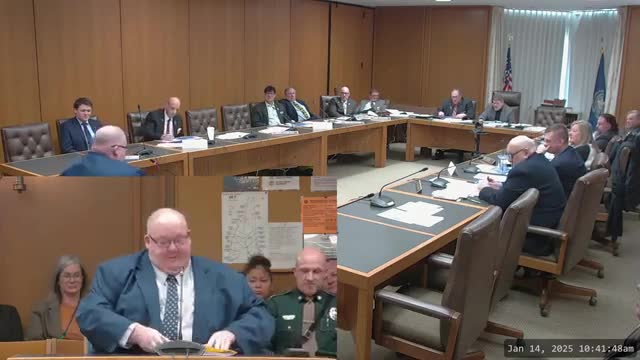Marine Patrol describes shrinking seasonal force, maintenance responsibilities and funding sources
January 14, 2025 | Transportation, House of Representatives, Committees , Legislative, New Hampshire
This article was created by AI summarizing key points discussed. AI makes mistakes, so for full details and context, please refer to the video of the full meeting. Please report any errors so we can fix them. Report an error »

Captain Tim Dunleavy, program specialist with Marine Patrol, told the Transportation Committee that Marine Patrol’s statutory responsibilities include enforcing boating laws on public waters (ponds 10 acres or larger), investigating freshwater drownings, providing boating education and maintaining aids to navigation.
Dunleavy said Marine Patrol maintains “just a little under 3,000, aids to navigation” (buoys, lights, danger signs and bridge navigation lights) and maintains 66 patrol vessels and about 135 engines and trailers. He described the unit’s staffing as a small full-time core — one state police lieutenant as commander, four sergeants and three full-time Marine Patrol officers — supported by seasonal officers. He said seasonal staffing has declined from typical historical levels of 65–85 seasonal officers to 21 this season.
He described Marine Patrol mechanics and maintenance operations — factory-trained mechanics who service the fleet and act as a Mercury Marine warranty center — and said the unit conducts about 600 commercial-boat inspections each spring in a concentrated period as operators prepare for summer. Dunleavy also described a Homeland Security Patrol on the seacoast staffed by three full-time patrol officers focused on escorts, port security, perimeter security and bridge security.
On funding, he described two primary sources: the Navigation Safety Fund, a dedicated revolving fund supported by boat registrations, boating-education revenues and mooring permits, and the Recreational Boating Safety Grant from the U.S. Coast Guard, funded by an excise on life-jacket and fishing-equipment manufacturers distributed nationally. He said both revenue streams are necessary to support Marine Patrol operations.
Dunleavy asked the committee to consider recruitment needs, noting a statewide trend across law enforcement for vacancies, and said Marine Patrol enjoys cooperative relationships with Fish and Game and other local responders for search-and-rescue and evidence-recovery work.
Dunleavy said Marine Patrol maintains “just a little under 3,000, aids to navigation” (buoys, lights, danger signs and bridge navigation lights) and maintains 66 patrol vessels and about 135 engines and trailers. He described the unit’s staffing as a small full-time core — one state police lieutenant as commander, four sergeants and three full-time Marine Patrol officers — supported by seasonal officers. He said seasonal staffing has declined from typical historical levels of 65–85 seasonal officers to 21 this season.
He described Marine Patrol mechanics and maintenance operations — factory-trained mechanics who service the fleet and act as a Mercury Marine warranty center — and said the unit conducts about 600 commercial-boat inspections each spring in a concentrated period as operators prepare for summer. Dunleavy also described a Homeland Security Patrol on the seacoast staffed by three full-time patrol officers focused on escorts, port security, perimeter security and bridge security.
On funding, he described two primary sources: the Navigation Safety Fund, a dedicated revolving fund supported by boat registrations, boating-education revenues and mooring permits, and the Recreational Boating Safety Grant from the U.S. Coast Guard, funded by an excise on life-jacket and fishing-equipment manufacturers distributed nationally. He said both revenue streams are necessary to support Marine Patrol operations.
Dunleavy asked the committee to consider recruitment needs, noting a statewide trend across law enforcement for vacancies, and said Marine Patrol enjoys cooperative relationships with Fish and Game and other local responders for search-and-rescue and evidence-recovery work.
View full meeting
This article is based on a recent meeting—watch the full video and explore the complete transcript for deeper insights into the discussion.
View full meeting
